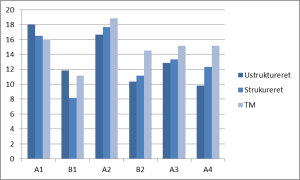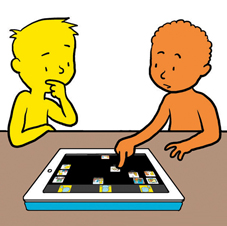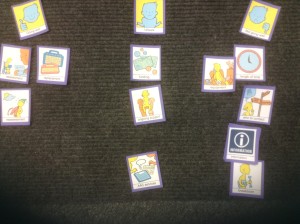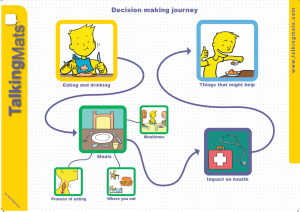We are very grateful to Kristine Pedersen from Kommunikationscentret in Denmark for sharing the findings of 2 projects with us. The first project found Talking Mats was effective in supporting communication for people who have dementia when compared with both unstructured and structured conversations.
‘t is important to know how to give people with dementia the right support’
At Kommunikationscentret in Hillerød (Denmark), we have been using the Talking Mats framework since our first trainer was accredited at the Talking Mats Centre, University of Stirling in 2010. We have been using Talking Mats with both children and adults across a range of communication difficulties e.g. caused by Aphasia, Cerebral Palsy, Downs Syndrome, learning difficulties etc. Inspired by the important research project by Dr. Joan Murphy and others ‘Decision making with people with dementia’ (2010), our next step was to gain our own experience within the framework specifically aimed towards people with dementia.
As in the rest of the world, the number of people in Denmark with dementia is increasing. Symptoms of dementia vary from person to person but many of the symptoms are related to communication: Difficulties finding words, using familiar words repeatedly, losing track in conversation, difficulties in focusing and paying attention etc. The growing dependence of the person with dementia on a caregiver makes communication essential to express wishes and needs. Therefore, it makes sense to look at the consequences of the illness (dementia) within the perspective of communication and how family members and professionals around the person with dementia can support communication using AAC.
The purpose of the first project was to compare the communication in conversations about views on I) Daily activities and II) The importance of information, using three different communication methods. The methods were: 1) unstructured conversation 2) structured conversation 3) the Talking Mats framework. The project involved 6 participants having early to moderate stage dementia, all living in residential care homes.
Like the study ‘Decision making with people with dementia’ (2010), the report concludes that the Talking Mats method was associated with better communication for the majority of the participants. The Talking Mats framework was found especially helpful regarding the participant’s ability to understand subject and question of the conversation, the participant’s ability to reflect, and the participant’s ability to make themselves understood. The graph below shows that only one participant (A1) did not benefit from the visual method. She had poor eyesight, which strongly indicates that visual support compensates the difficulties that people with dementia have.
The report also concludes that the Talking Mats framework increases the interviewer’s ability to detect and compensate for some of the communication difficulties. Finally, it seemed that several of the participants have been able to learn how to use Talking Mats in the process.
The photo underneath shows a Talking Mat conversation from the project. This Talking Mat gives an insight into how this person feels about what information is important to her, and what isn’t. It is in some way a difficult and abstract question, but most of the participants managed to both understand, reflect and answer the question when we used the Talking Mats framework.
Important information to this participant is information about new neighbours, the menu at the residential care home, economy etc. Less important is news about the Danish royal family, technology, getting older etc. Politics is definitely not important to her.
We are delighted that Nick Stewart, Director, Software and Products with Arum Systems, the IT Consultancy who have built the Digital Talking Mats has chosen TM as his favourite project for a case study.
Here is an extract from his case study describing the Challenge and Process of working with Talking Mats.
The Challenge
The challenge was taking the existing physical Talking Mats tool and building a digital application suitable for multiple platforms, while maintaining the core ethos of the tool. A significant amount of academic research went into creating the physical product and those principles had to be present in a digital version. The applications had to be extremely intuitive to use and enable better conversations for people with communication difficulties.
The aim was to create 3 digital versions; a browser based version for laptop users and a tablet version for iPad users and Android users. Each application would connect to a cloud server, allowing users to log in from any device, and the tablet versions would allow offline working through syncing with the cloud when a connection was available. There was a requirement to set up a multi-tiered subscription based user account system to match the intended charging model for the digital app.
Our Process
Arum’s approach was to totally immerse ourselves in the Talking Mats business to understand their goals, ethos and objectives. We took time to learn how the Talking Mats ecosystem worked and how they wanted to engage with their customers. By applying our 3D Methodology we were able to break down the deliverables into phases allowing the key building blocks to be delivered first. This also allowed the best use of budget and reduced the time to market the new product.
To read the full case study click here Arum Talking Mats Case Study

- This tool will be useful in helping some residents make decisions, informed choices and express their needs. It will take time for some residents to feel confident in using this tool.
- I’d like to use it with some residents to be able to adapt Talking Mats more to their understanding.
- I’d like to use this tool for resident’s reviews to find out what the residents likes/dislikes are.
- Talking Mats will be great for service evaluation.
- Talking Mats will be great for asking residents about things they want to do.
- Updating Care Plans regularly from outcomes of Talking Mats.
- It can be used to get to know people’s needs and wishes more.
- Share the findings with colleagues and joint services.
- Hopefully through its use I’ll learn to pass it onto others.
- A gardening set. Service evaluation and well-being assessing stress levels/anxiety/emotional state?
- I’d use it to promote choices of activities.
- Care Inspectorate forms. Finding out how people enjoy time at the service and how to improve on it.
Can you let us know how you use Talking Mats as part of your work?
We are very grateful to David Brennan, a Dementia Support Worker from Ayrshire for this powerful blog.
Over the years our service has supported many people with a diagnosis of Dementia, now and then we encounter individuals whose cognitive difficulties have greatly affected their ability to communicate. This can (in some cases) result in distress for the services user and their families, distress that could be reduced or even avoided if the individual had a way of being understood by those around them.
As a service we welcomed the opportunity to engage in the Talking Mats Training and as a Dementia Support Worker I was eager to have a tool that could help me overcome communication obstacles, having experienced situations where those I support become so frustrated because they desperately want to relay a piece of information, but simply cannot find the words to express themselves.
I saw talking Mats as a communication system for those who struggle with speech. However, after using the practice in a practical environment I realise that I have had underestimated its potential, for it has much wider applications in our role.
My first experience of using Talking Mats was when producing the video for the second training session. I enlisted the help of a gentleman from the neighbouring Day Care centre.
We had never met prior to the session. The Gentleman had no communication difficulties that I was aware of.
Using the Talking Mats acted as an instant ice breaker, giving two complete strangers a reason to sit down and interact together, quickly striking up a rapport. The Gentleman appeared at ease and was happy to talk in detail about the tiles for the chosen subject of ‘Leisure Activities’
The activity revealed more than expected though. Through the course of the conversation he voiced feelings on things he was perhaps not happy with. I discovered he was unhappy that he did not get out in the open air enough due to poor mobility and that he would have preferred to see musicians coming into his Day Care Centre. This was crucial feedback
It occurred that Talking Mats also had an effective use in the assessment and quality assurance process that exist within services, providing crucial feedback for continued person-centred planning.
Taking this on board I considered examples of service users within my current caseload where the activity could prove beneficial.
I have been working with one gentleman for many months. He could be described as a Man’s man, someone who often replies to attempts at conversation with short responses, even when speaking with his wife. He may struggle to remember the names of people and places but he typically has little other difficulty in communicating.
I attempted the same topic with this man. Much of the answers were as expected. He spoke about football and his favourite team, but the structure of the Talking Mats encouraged him to open up about some of the smaller details that until now he hadn’t felt the need to disclose.
In the most recent example I was asked to take part in a colleague’s Talking Mat video for her training. She is one of our newest members of staff and although we have already developed a good working relationship the activity allowed her more insight to the nature and history of her co-worker.
For my experience, as someone who can struggle with sensory stimulation, it allowed me to express some of my needs and obscure preferences (around the office and in general) in a safe environment where I felt able to communicate what would normally be very personal information. And to have someone listen and thoughtfully consider this was a rewarding experience too.
As a service, new to the Talking Mats system, we are just scratching the surface of how we can best implement this into our roles, but the possibilities are already multiplying at a rapid pace, almost as much as the benefits we are seeing.
David Brennan
Dementia Support Worker
This post is about the importance of the Talking Mats blog and how it can be used as a rich resource of information for anyone interested in communication. One of the first ‘tasks’ that I was asked to do after starting my new job at Talking Mats was to create and give a presentation to an international audience of trainees at our most recent course for Accredited Trainers. I had only been in post for 2 weeks and I was also a trainee on the course, so the pressure was on!
The main aims of the presentation was to promote the Talking Mats Blog as a source of rich information which is accessible to anyone, that Accredited Trainers can use it in their own training courses, and also to encourage Accredited Trainers to write their own blog posts to describe how they use Talking Mats in their working and personal lives.
I wanted to try and make the presentation look a bit more dynamic than the usual ‘death by PowerPoint’ that can sometimes occur after a whole day of looking at slides! I decided to use Prezi, “a cloud-based presentation software and storytelling tool for presenting ideas on a virtual canvas”, as I’d had good feedback about it when I had used it in the past and thought this would be a perfect opportunity to roll it out again. You can see the completed presentation here.
When the day came to give the presentation, I wasn’t feeling on top form after having flu for a few days previously. Because of this my memories of it are rather hazy (which isn’t good for the purposes of writing a blog about the presentation!) but from what I’ve heard, apart from looking ill, I managed to get my points across without confusing (or frightening) the audience!
It was a fantastic opportunity to take part in the Accredited Training course and to hear the stories of all the trainees who are dedicated to using Talking Mats to improve the lives of the people they help on a daily basis.
I’ve also just found out that the team at Talking Mats have been blogging for 4 years, so get reading!
As part of the Right to Speak initiative Talking Mats was funded to develop ‘Promoting Inclusion and Participation’: an online learning resource for staff working with children and young people who use Alternative Augmentative Communication (AAC). We have been delighted to work with NHS Education Scotland on developing this free resource and also have really enjoyed working in partnership with the learning and development consultancy: Forum Interactive.
The complexity of care for children and young people who use Alternative and Augmentative Communication (AAC) is multifaceted. Ensuring that goals are centred on the young person and family’s needs is a constant challenge to practitioners. There are several resources that focus on developing the technical skills of developing AAC but there is a scarcity of resources that focus on the impact of AAC on the child’s day to day life.
Promoting Inclusion and Participation is based on an earlier project which determined the key indicators of a quality AAC service from the perspective of AAC users and their families.
Promoting Inclusion and Participation uses the following frameworks to help practitioners structure their decision making:
- International Classification of Functioning, Disability and Health – Children and Young People (ICF-CY)
- Janice Light’s Communicative Competencies (2014)
- GIRFEC (Getting It Right For Every Child) wellbeing indicators
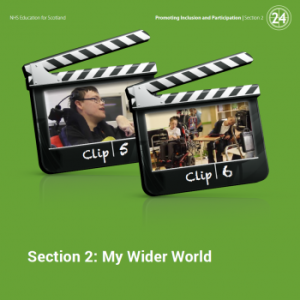
This on-line resource will help practitioners:
- Understand the role that collaboration and involvement play in delivering wellbeing outcomes for children who use AAC.
- Apply a holistic approach and outcomes focused approach to assessment, implementation and review which places the child at the centre.
- Recognise that as the child develops and changes, so the level of different team member’s involvement will ebb and flow.
Download the resource here. It takes a little time to download so be patient !
We would be delighted to receive feedback of how it is being used.
Ref
Light J , Mcnaughton D, Communicative Competence for Individuals who require Augmentative and Alternative Communication: A New Definition for a New Era of Communication? Augmentative and Alternative Communication, 2014; 30(1): 1–18
Handing over control of communication seems to be the most difficult of all the skills we need to have when we are taking part in communicative exchanges. Just how difficult this is, even for skilled communicators, can be clearly seen when people are using Talking Mats. Handing over control of communication is one of the fundamental principles of the talking mats framework. If the person has the physical skills, the facilitator physically hands over this control by handing the person the symbol (and of course other approaches are used when the person does not have the physical skills). The ‘thinker’ (the person who is doing the Talking Mat) then places the symbol on the Talking Mat, under one of the points on the pre-agreed top-scale, having been asked an open question e.g. how do you feel about …….?
When facilitators are learning about this approach, they seem to find it easier to ask open questions, slightly harder to stick to the agreed top scale but really difficult to hand over all of that control. As part of the training, participants film themselves using Talking Mats with someone. We use that clip to reflect on the facilitators’ skills, by taking about things that we liked and then reflecting on ‘it would have been good if…….’
The video clips work really well as participants can see themselves making the errors of retaining control in small (but nonetheless significant ways) e.g.
• Having the mat facing themselves rather than the ‘thinker’
• Moving the symbols after they have been placed by the ‘thinker’ to tidy them up/to make it easier for facilitator to see them
• Forgetting to give a neutral response where ever the symbols are placed (even if the facilitator thinks that the symbol has been ‘misplaced’)
• Telling people that they must place the symbols in rows underneath one another
• Not letting people use the top-scale creatively e.g. by placing the symbols at specific points between the top-scale e.g. to represent unsure but I am more happy with it than not.
The great thing about the Talking Mats training is that participants noticed these things that they were doing and will be working hard at noticing and doing them less in future.
We find it hard to give up control and find it hard to notice the things we do to retain this control, even when we are working within the talking mats framework. This is a framework where we are ‘symbolically’ handing over that control in the form of giving someone a symbol and so have a very obvious reminder of whose turn it is. How many ways then must we do it in everyday conversations and never notice? After all, in every day conversations, there are typically much less obvious reminders of whose turn it is and who should be in control.
Many thanks to Dr Jill Bradshaw, Lecturer in Learning Disabilities/Consultancy Development Manager, Tizard Centre, University of Kent for this thoughtful blog.
In June 2012 the Scottish Government published “A Right to Speak” (Scottish Government 2012) which included a four million pound fund to help improve services in Scotland for people who use Alternative and Augmentative Communication (AAC). At that time we were a small fledging social enterprise with a vision to improve the lives of people with communication difficulties in Scotland. We have been fortunate to be able to make our contribution to Right to Speak and as the initiative ends at the end of this month it is good to reflect on the work that we have contributed to over the past 3 years.
AAC outcomes
At the beginning we were heavily involved in the research aspect of the project, carrying out a critical appraisal of outcomes for people working in AAC. This led onto a second project to evaluate the validity and reliability of the Therapy Outcome Measure for AAC. We were pleased to be able to do this in conjunction with Prof Pam Enderby and a number of AAC professionals throughout Scotland. The Therapy Outcomes Measures, third edition has just been published which includes a section on AAC co-written with Joan and Sally. This should allow professionals to be much more specific in monitoring and measuring the impact of AAC intervention.
Quality indicators
A second piece of research we carried out was to explore what matters to AAC users in terms of service delivery. It was a great privilege to listen to the views of people who use AAC from all over Scotland and we were able to theme those views into 10 key quality indicators. This led on to one AAC partnership asking us to design a Talking Mat to enable AAC users to give feedback on their service. This was successful and NHS Education then asked us to roll that out across Scotland. 40 people have just attended 4 specialist seminars and received the resource. We believe that taking the time to listen to people and ask for feedback in a structured way is really important and so to continue to support that we are making the ‘Talking Mats AAC feedback’ script ,symbol set people and symbols set services available on the free stuff section of our web site.
Promoting Inclusion and Participation
We were fortunate to win the tender to design an online learning resource for staff working with children and young people. It is designed to help professionals take a holistic and values based approach to working with young people to support their health and wellbeing. The resource contains a collection of film clips that depict three different environments in which young people use AAC: a mainstream primary school, a mainstream high school and a specialist school. It provides a Learner’s Workbook which shows the learner how to use the film clips to improve the way they promote inclusion and participation for young AAC users. It will support equip practitioners to shift from a model of working where interventions are done to the child/young person to a process where work is done with children and families to focus on what is important to them. It is about to launch on the NHS Education web site.
Training and accredited training
There has been a significant focus on developing a well trained staff through the right to speak initiative and helping people understand about communication. We have been delighted to play our role in that. Up and down Scotland we have run training courses for different AAC partnerships e.g Lanarkshire, Fife, Highland, Western Isles, Tayside. We have also had people coming to train here in Stirling .We are particularly pleased that there have been several people who have completed their accredited trainers and who will be able to continue and sustain training in their local area. In one Health board for example, there is a plan to train a further 300 front line staff in Talking Mats
Moving forward
It’s been a busy 3 years and it’s both exciting and gratifying that so many more people know about AAC and know that it is not a responsibility that rests with just one profession . The complexity of communication means we all have to play our part but we all recognise there is still much to do to really ensure people who use AAC are fully included in society.
As a social enterprise we would no longer describe ourselves as ‘fledgling’ –we have well and truly hatched ! We are grateful that during our critical start-up period winning tenders for right to speak also helped us on our journey. We will continue to fulfil our vision of supporting people with communication difficulties and we recognise right to speak has given us a legacy of research and resources that will help us do that.
Getting feedback on AAC services is particularly challenging because of the communication support needs of this group of people. It is therefore really important for AAC users to have the chance to say how they feel about the services they receive. Services need to make sure that this group of people have a voice and that there is a mechanism for their views to be taken into account in monitoring the quality of services and service planning.
NES has funded the opportunity for professionals to attend a seminar and go away with a resource to support them to get feedback from AAC users about their service. The Talking Mats resource was trialled and developed with Forth Valley AAC partnership and is based on AAC quality indicators (NES 2013).
This opportunity is free of charge to people in AAC partnerships in Scotland. You will attend a half day specialist seminar and go away with a free resource to use in practice.
The resource will help people find out how AAC users feel about:
- People who work with them
- How AAC services are delivered
It provides a model of good practice which could be extended to evaluate other services.
4 dates and locations are available.
Edinburgh- Tuesday 17th March 1.45 -4-.30pm
Dundee – Wednesday 18th March 1.45 -4.30pm
Glasgow Thursday 19th March – 1.45 -4.30pm
Inverness Friday 20th March 1.45 -4.30 pm
If you are trained in Talking Mats and wish to take up this great opportunity, please book your place as soon as possible.
sally@talkingmats.com or rhona@talkingmats.com
Recently we delivered two Talking Mats specialist seminars in London:
- Talking Mats and the Eating and Drinking resource
- Talking Mats and Capacity
Both seminars were very well attended with lots of discussion from a wide range of professionals.
During the Eating and Drinking seminar, we provided background on how and why the resource was developed and showed some DVD examples of people using the resource. This really brought things to life and showed how important it is to give people (with and without speech) the opportunity to consider and talk about different aspects of eating and drinking. We also gave people hands-on practice in using the symbols from each topic.
Each participant received a copy of the full resource, including symbols, a mat, and explanatory booklet.
During the Capacity seminar we discussed the fundamental principles the Capacity Act and participants had a chance to consider how Talking Mats can help people to:
- understand
- retain/remember
- weigh up information
- communicate their views/wishes and feelings.
They were also given the opportunity to work through some practical examples and think about options to help people understand issues and make decisions.
If you would like to attend our next specialist seminars, we are holding them in Stirling on 17th February: Stirling Seminars Feb 2015 flier
 Online training login
Online training login 

